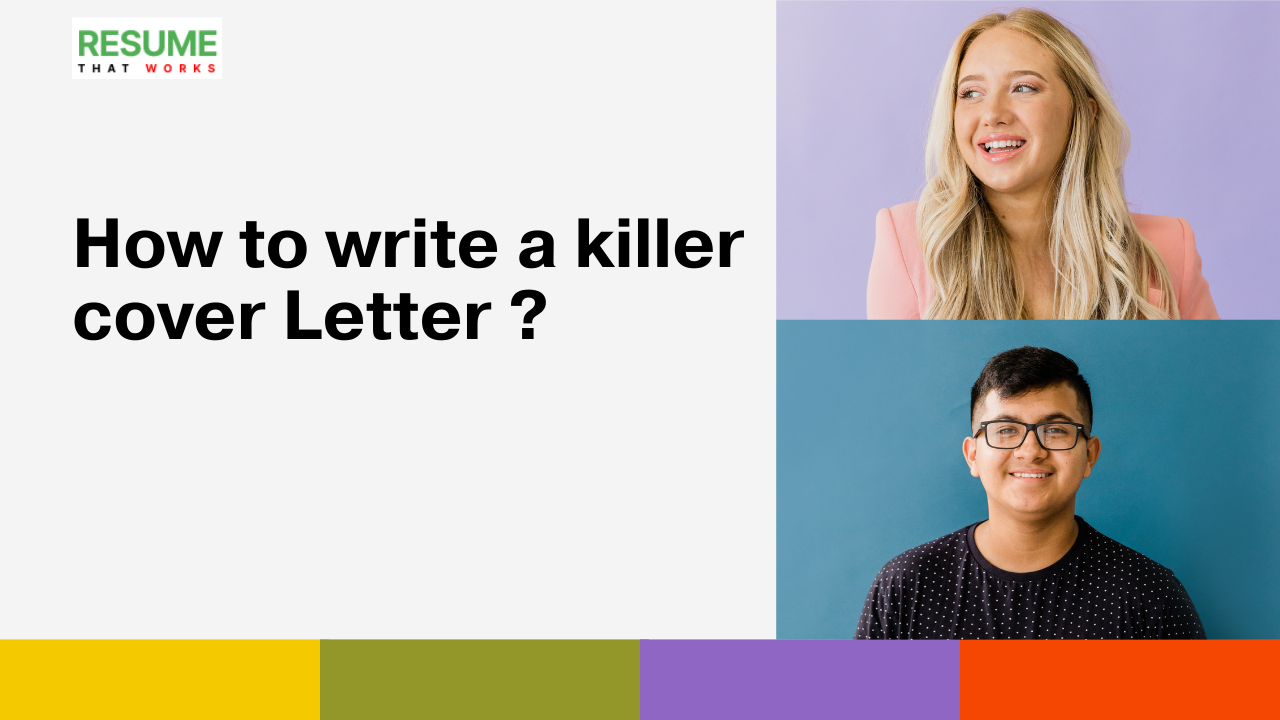Many job seekers nowadays put all their focus on creating a great resume but overlook the importance of a cover letter. However, if a cover letter is necessary for a job application, most jobseekers hurriedly and carelessly put together a cover letter without caring for detail. By doing that they miss out on almost all important details that should be included in a cover letter.
Writing a great cover letter takes time and effort and it can make all the difference between you getting a call for an interview or not. However, writing a cover letter all by yourself without looking at any samples or without seeking any professional help will almost end up with you having a crappy cover letter that is missing all the important points.
To ease your troubles, expert cover letter creators from ResumeThatWorks took the time to write down this article to help you create great cover letters. Please carefully read this article from start to finish to understand all the important details that should be included in your cover letter.
What is the Difference Between a Resume and a Cover Letter?
A resume only highlights your major achievements, experiences, accomplishments, and information about your certifications and education. A resume is nothing more than a showcase of the key highlights of your personal experiences and accomplishments throughout your professional career.
On the other hand, a cover letter adds a personal touch to your professional experience and expertise. A cover letter enables you to show a bit of your personality in your profession. A cover letter showcases how you were able to achieve all that for your previous employers and how diligent and hardworking you are. Unlike a resume, you can also explain why you are the best candidate for the role that you are applying for.
7 Pro Tips on How to Write a Perfect Cover Letter for Any Job
Wondering how to write a killer cover letter that stands out? Well, you are not alone, many people struggle to write cover letters according to the job description.
These are the reasons why expert career counselors and resume writing experts from ResumeThatWorks have prepared these pro tips and tricks for you to understand how to write a killer cover letter.
Pro Tip # 1: Start With A Killer Opening Line
A wise man once said that your first impression is your last impression, I agree with him in this regard. Hiring managers go through a ton of resumes and cover letters from people every day. They can easily identify if you copy-pasted some crappy opening lines from the internet. Remember that you need to impress the hiring manager by showcasing your unique personality and talents. You need to bring something new to the table that makes the hiring manager say “this person looks better than the rest”.
The worst of all cover letter opening lines there can ever be is to write “To Whom It May Concern”. This shows that you have sent the same cover letter to hundreds of other employers as well. This also shows that you did not do any research about the company and just sent a pre-written cover letter without any editing. Such types of job applications go straight to the dust bin, we know it’s harsh but it’s the reality. For a chance to stand out with your cover letter you need to follow these instructions.
- Try to know the name of the decision-maker or hiring manager. You can most probably find it in the job description or the Email that you receive, however, if it’s not listed there go to the company’s website and find it yourself.
- Start your cover letter by addressing the hiring manager/ concerned person with his/her name.
- Addressing the hiring manager by his/her name will make a strong first impression. This indicates that you took the time to research the company, read the job description, and explored the company’s Linkedin profile.
Pro Tip # 2: Make it unique to the job
Rather than sending a generic letter that could apply to any job at any company, your opening sentence should show that your letter was crafted in response to this specific job. For example, “I was thrilled to see your listing for a data entry specialist in the Cleveland office” says a lot more than “I am responding to your job opening.”
Pro Tip # 3: Be Clear and Concise While Writing
Try to write in active voice tense and not passive voice. Use a conversational tone like the one you will use if you are standing right in front of the hiring manager. Avoid superlatives and pretentious language. Also, avoid small phrases that don’t give full meaning and avoid jargon.
Use simple words, however, write sentences through which you are able to give the most meaning from small words. Carefully proofread and edit your content before submission to ensure the highest quality. Here are some tips from our career experts:
- Always use an active voice tone.
- Use simple words and avoid jargon.
- Stick to the point and stay relevant to the job description.
- Proofread and edit your document 3-4 times before submission
- Look for grammatical errors as well as punctuation errors.
- Ask a friend or a colleague to proofread the start of your cover letter before submission.
Pro Tip # 4: Only Include What’s Relevant
More like your resume you should only add relevant details that directly relate to the job role you are applying for. However, unlike your resume where you only highlight WHAT you have done in the past, your cover letter enables you to say HOW you were able to do all that.
Also, make sure you directly respond to all the questions asked in the job description section that needs “what we are looking for”. For instance, if the job description says that they need a person with sales experience then mention your sales experience in your cover letter.
Pro Tip # 5: Don’t just repeat what’s on your resume
Your cover letter is your chance to showcase a bit of your personality and not just highlights like in your CV. Instead of repeating what’s already listed in your resume, focus on adding a bit of a personal touch to your professional story.
However, don’t try to tell them how that job will be so good for you, else, focus on why you are the best fit for that role. Focus on why hiring you would be so much better for the company and how are you better than the rest of the people who also applied for that role.
Pro Tip # 6: Offer examples of what you’ve done in past
Unlike a resume, a cover letter is your chance to show examples of what you have done in the past. Just make sure you carefully read the job description before you start writing. For instance, if a company is looking for someone with great communication skills then elaborate on how your experience as a communications specialist will help them.
Don’t focus on why you need this job and how this job can help you financially with your problems. Employers want to see what you can do for them and not what they can do for you. Even if you are a fresh graduate or only have a college degree you can still how what you did in your summer holidays.
Pro Tip # 7: Finish on a Strong Note
Never ever say things like “you will be highly obliged if you get this opportunity and you will give your best” employers do really care about what benefits you get. Employers are more interested in what you can do for them and the company as a whole.
However, we are not suggesting that you don’t show your enthusiasm for the job role. Sounding enthusiastic and optimistic that shows your genuine interest in the role will show that you are interested in the job role being offered. Add a thank you note for the hiring manager’s time and consideration. Also mention that you are always available for discussing more the role and you are looking forward to hearing back from the hiring manager.
Killer Cover Letter Format
The format of a cover letter is generally very simple and flexible. The cover letter format can be adapted based on the job description and requirements. If you are not sure about drafting a unique cover letter format then you can use the following format:
- The Header Section:
Start with your name and contact details and then add a blank line. Follow the blank line with the hiring manager’s name and company information. Don’t forget to include your Linkedin profile in the header section. - Short, Concise, and to the Point:
Don’t write an essay, try to keep your cover letter short. 3to 4 paragraphs are more than enough for a cover letter. Start with a hook statement and try to keep your content interesting and engaging for the hiring manager to read. - The Middle Paragraphs:
After the introductory paragraph, show how you are a great fit for the company and how you fulfill the job description. Also, share how you did everything for your previous employer. - Cover Letter Page Style:
We recommend a 1-inch margin from the top, bottom, and two sides. - Font Style of Cover Letter:
There is no specific font style you can use whatever you like but make sure you don’t change your font. Only use one font style. - Cover Letter Line Spacing Format:
The cover letter line spacing should either be 1 or 1.15 so that you can add as many words as you can without going to the next page.
Cover letter margins. Stick to a full inch on the top, bottom, left, and right. - Best font for cover letter. Use only one font, but make it a respected, easy-to-read one like Cambria, Calibri, or Didot.
- Line spacing. Cover letter line spacing should be 1 to 1.15. Don’t get creative with this part of it.
Cover Letter Examples
Writing cover letters is not an easy task and you should never write one without looking at any samples. Look at the different cover letter samples to see how to actually write a great cover letter.




